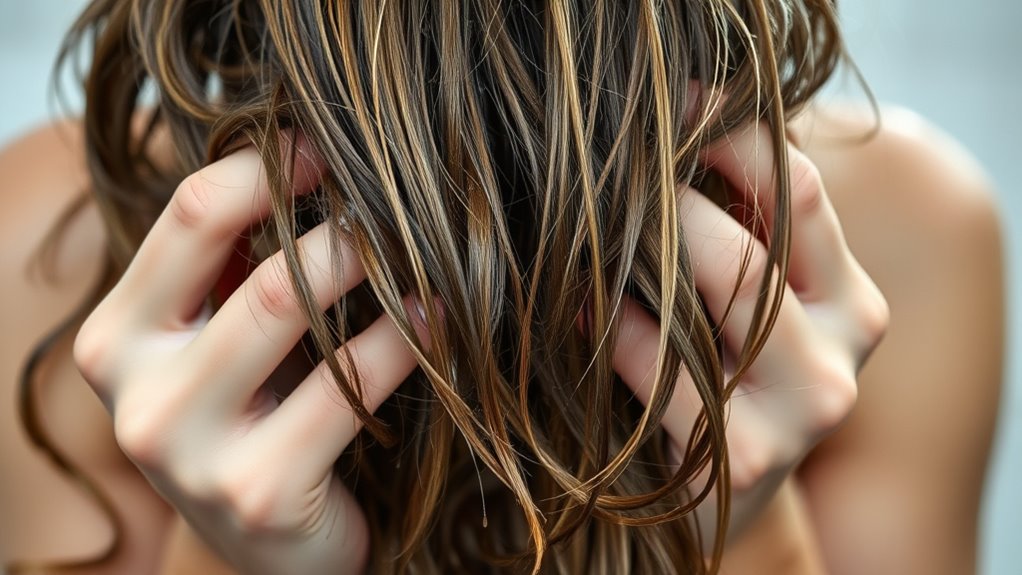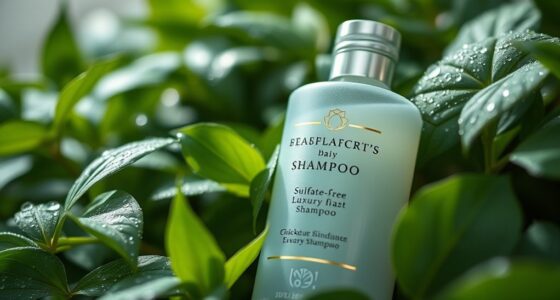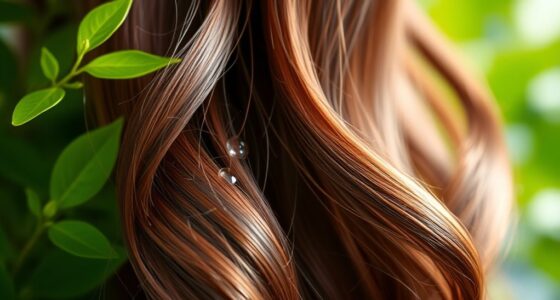The main mistake causing your frizz and breakage is washing your hair too often with hot water or using improper techniques. Hot water strips natural oils, leaving hair dry and frizzy, while over-washing can disrupt scalp balance and weaken strands. Rushing the towel-drying or applying too much product also leads to damage. If you keep these habits up, your hair will remain prone to frizz and breakage—keep going, and you’ll discover how to fix it.
Key Takeaways
- Washing hair too frequently or infrequently can strip natural oils, leading to dryness, frizz, and breakage.
- Using hot water instead of lukewarm or cool water damages cuticles and causes frizz.
- Applying excessive product or not distributing it evenly causes buildup and weakens hair strands.
- Rubbing hair vigorously with a towel damages cuticles and increases frizz and breakage.
- Neglecting proper rinsing leaves residue, leading to dullness, buildup, and increased fragility.
Washing Hair Too Often or Not Enough
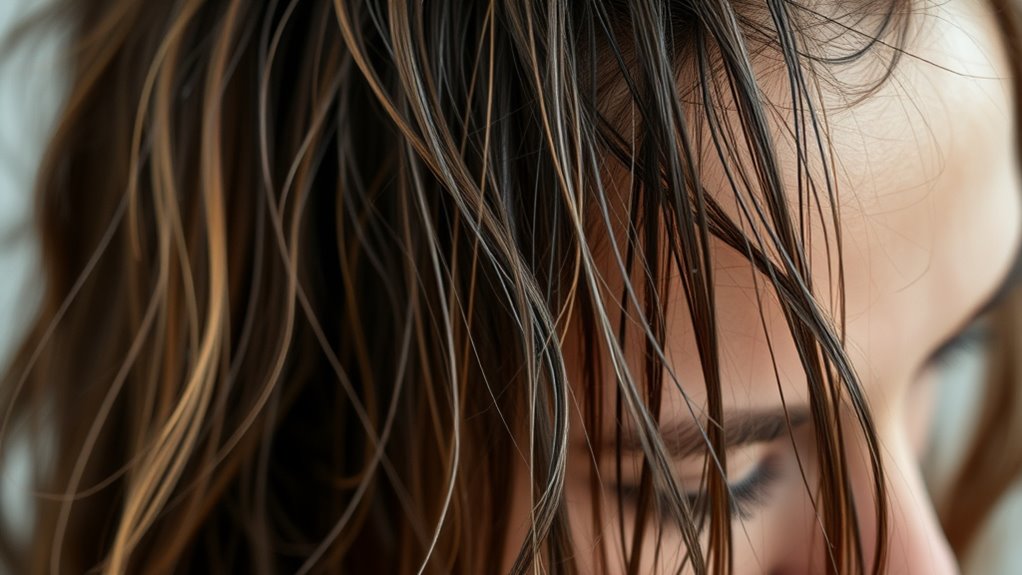
Finding the right balance in hair washing is essential because washing too often or not enough can harm your hair’s health. If you wash your hair too frequently, you strip away natural oils, leading to dryness and increased frizz, especially for curly or textured hair. Over-washing can also cause your scalp to produce even more oil, creating a cycle of greasy roots and dry ends. On the flip side, washing too infrequently allows dirt and product buildup to accumulate, weighing your hair down and increasing the risk of breakage. The key is to find the right frequency for your scalp and hair type—experts recommend at least every other day—to maintain a healthy scalp, reduce excess oil, and prevent both frizz and damage. Understanding your specific hair type and scalp condition can help determine the optimal washing schedule for your hair health. Additionally, choosing the right hair washing routine tailored to your needs can improve overall hair health and minimize damage. Regularly assessing your scalp health can help you adjust your washing frequency as needed to avoid issues like dryness or excess oil buildup, especially since using the right products can also promote healthy hair growth. Incorporating proper hair care practices can further enhance the overall health and resilience of your hair.
Using the Wrong Shampoo and Conditioner
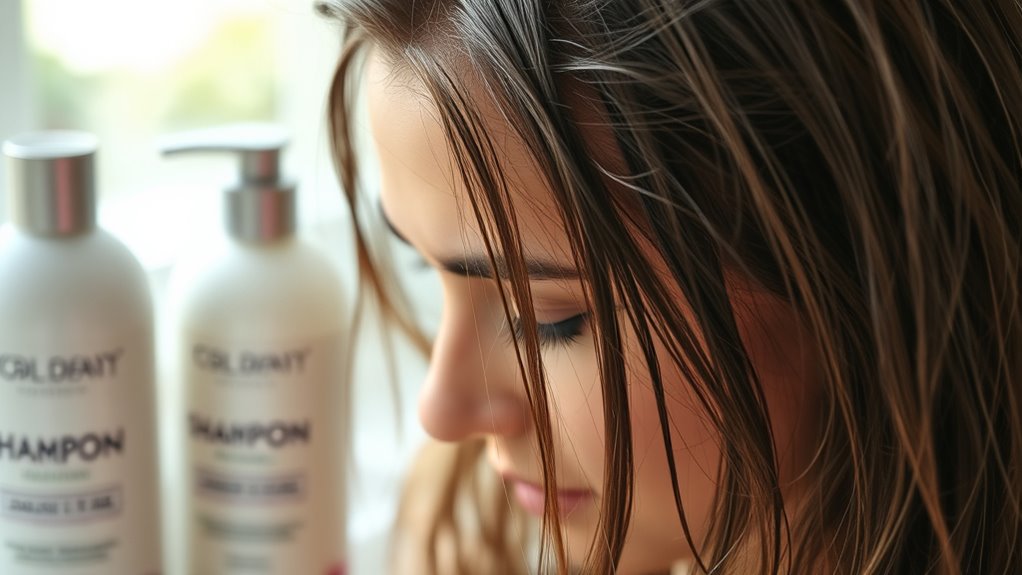
Using the wrong shampoo and conditioner can do more harm than good to your hair. If your products don’t match your hair type, you might notice dryness, frizz, or flat strands. Choosing formulas suited to your specific needs keeps your hair healthy and looking its best. Additionally, using the right products can help prevent damage caused by unsuitable hair care products. Staying informed about AI security vulnerabilities ensures that your hair care routine remains effective and safe from potential risks. Regularly updating your knowledge about hair care technology can further improve your routine and hair health. For instance, understanding how water-based treatments impact hair can help you select more effective products, as exploring how creative practice influences your overall approach can lead to better hair care solutions.
Match Products to Hair Type
Are you choosing the right shampoo and conditioner for your hair type? Matching products to your hair type is key to avoiding hair damage and maintaining a natural shine. If you have dry or curly hair, moisturizing formulas nourish your strands and reduce frizz, while fine or oily hair needs lightweight, clarifying, or volumizing products to stay manageable. Using the wrong products creates a product mismatch that can lead to buildup, uneven moisture, and increased breakage. When your hair products are suited to your hair type, they work together to improve texture and reduce issues like dullness or frizz. Recognizing hair care technologies can also provide guidance and reassurance about your hair health. Incorporating proper hair maintenance techniques, such as regular deep conditioning or scalp treatments, can further enhance your hair’s health. Regularly reassessing your hair needs and selecting the right formulas helps prevent damage and keeps your hair looking healthy and vibrant. Additionally, understanding the cycle of breakups in your relationships can help you maintain emotional balance and confidence as you care for yourself. Knowing how personal development techniques can support your overall well-being further enhances your ability to care for your hair and yourself holistically.
Avoid Mismatched Formulas
Choosing mismatched shampoo and conditioner can undermine your hair care routine, as incompatible formulas may cancel out each other’s benefits. When you use mismatched formulas, ingredients might not work well together, leading to ineffective cleansing or conditioning. This mismatch can also cause over-conditioning or under-conditioning, resulting in dullness, increased frizz, or weighed-down hair. Using compatible products ensures active ingredients work synergistically to nourish, hydrate, and strengthen your hair, reducing the risk of hair damage and breakage. Proper product pairing enhances overall effectiveness and helps maintain scalp health and prevents the buildup of conflicting ingredients. If you have color-treated hair, pairing color-safe shampoo with the right conditioner prevents color fading while maintaining hair health. Consistent product selection helps sustain scalp health and keeps your hair looking smooth, shiny, and frizz-free.
Getting Into Hot Water Instead of Warm
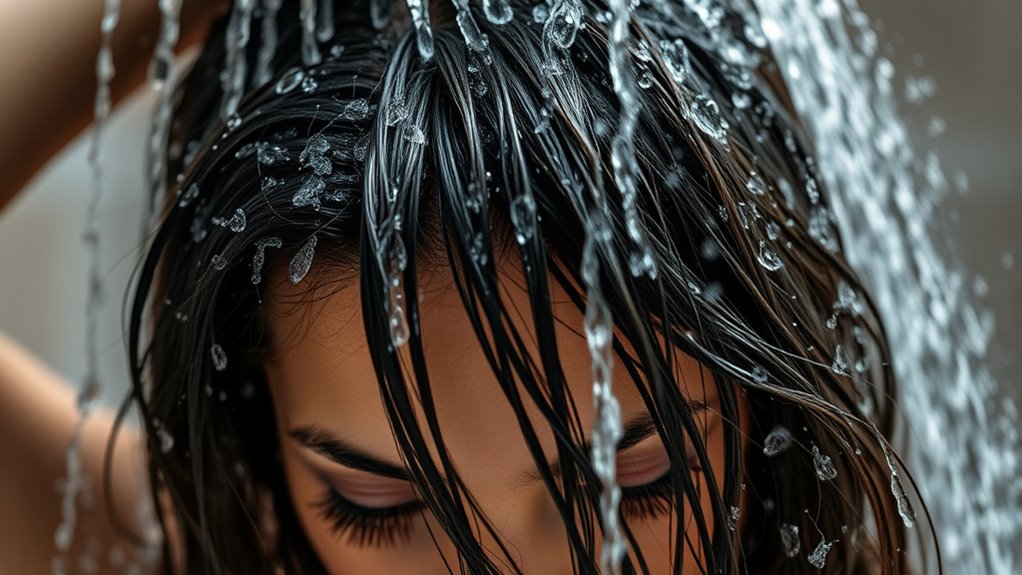
While it might be tempting to rinse your hair with hot water, doing so can do more harm than good. Hot water strips natural oils from your hair and scalp, leaving your hair dry and frizzy. It weakens the hair cuticles, making strands more prone to breakage during washing hair. Using water that’s too hot disrupts the scalp’s natural oil production, which can worsen frizz over time. Instead, opt for lukewarm or warm water to balance cleansing and moisture retention. This helps reduce dryness, frizz, and breakage. For added shine and smoothness, finish with a cool rinse to seal the cuticles. Keeping the water temperature moderate ensures healthier hair and a more effective washing routine, avoiding the damaging effects of hot water. Being mindful of hair care practices can also help conserve water and prevent plumbing issues during your hair care routine.
Applying Too Much Product or Not Distributing It Properly
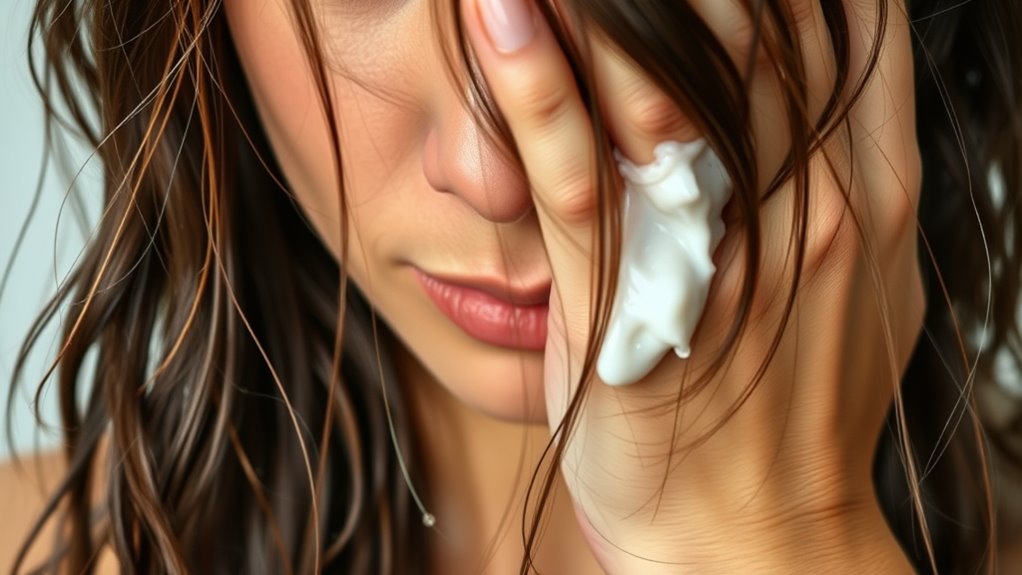
Applying too much product or not distributing it properly can undo the benefits of your hair care routine. Excess product weighs hair down, leading to frizz and buildup that’s hard to rinse out. To avoid this:
- Use the right amount of shampoo and conditioner—more isn’t better.
- Focus conditioner on your ends, not your scalp, to prevent excess weight.
- Distribute product evenly through your hair to ensure all strands get proper moisture.
- Rinsing becomes difficult with over-application, leaving residue that causes hair damage and breakage.
Rushing the Drying Process With a Towel

Rushing to dry your hair with a towel can cause friction that leads to frizz and breakage, especially if you rub vigorously. Instead, gently squeeze or blot your hair with a soft microfiber towel to protect your strands. Choosing a gentle drying method helps keep your hair healthy and minimizes damage.
Rubbing Causes Damage
Rubbing your hair vigorously with a towel can cause significant damage by creating friction that harms the delicate cuticles. This rough action strips moisture, increases frizz, and weakens hair strands, especially when wet hair is involved. To avoid damage, consider these tips:
- Use a microfiber or soft cotton towel instead of rough fabrics.
- Gently squeeze or press your hair to absorb excess water rather than rubbing.
- Avoid tugging or pulling on tangled hair during towel drying.
- Be patient—allow your hair to air dry or use a gentle patting motion to minimize breakage and maintain your hair’s natural texture.
Use Gentle Squeezing
To minimize damage during towel drying, gently squeeze excess water from your hair using a soft, absorbent microfiber towel. This gentle squeezing helps remove moisture without causing friction that can lead to hair damage and frizz. Rushing the drying process by rubbing vigorously can roughen the cuticles, increasing the risk of split ends and hair breakage, especially when your hair is wet and more fragile. A microfiber towel is ideal because it reduces tangles and minimizes tension on delicate strands. Instead of harsh rubbing, press and squeeze softly to preserve your hair’s natural texture and moisture. Taking this careful approach prevents unnecessary damage, keeps your hair smooth, and reduces frizz, all while maintaining its overall health and integrity.
Choose Soft Towels
Choosing the right towel plays a key role in drying your hair gently and effectively. Soft towels, like microfiber ones, minimize towel friction and protect your delicate strands from hair damage. Rushing the drying process with a rough or thick towel can cause tangling and breakage, weakening your hair over time. Instead, opt for a microfiber towel or a soft T-shirt to gently squeeze out excess water, reducing friction and preserving the cuticle. This gentle drying method helps prevent dryness and frizz while maintaining natural oils. Remember, the goal is to dry your hair without roughing up the cuticle or stripping away moisture, so prioritize soft towels for better hair protection and smoother, shinier results.
Items for gentle drying:
- Microfiber towel
- Soft T-shirt
- Patting instead of rubbing
- Light squeezing of excess water
Not Rinsing Thoroughly for a Clean Finish
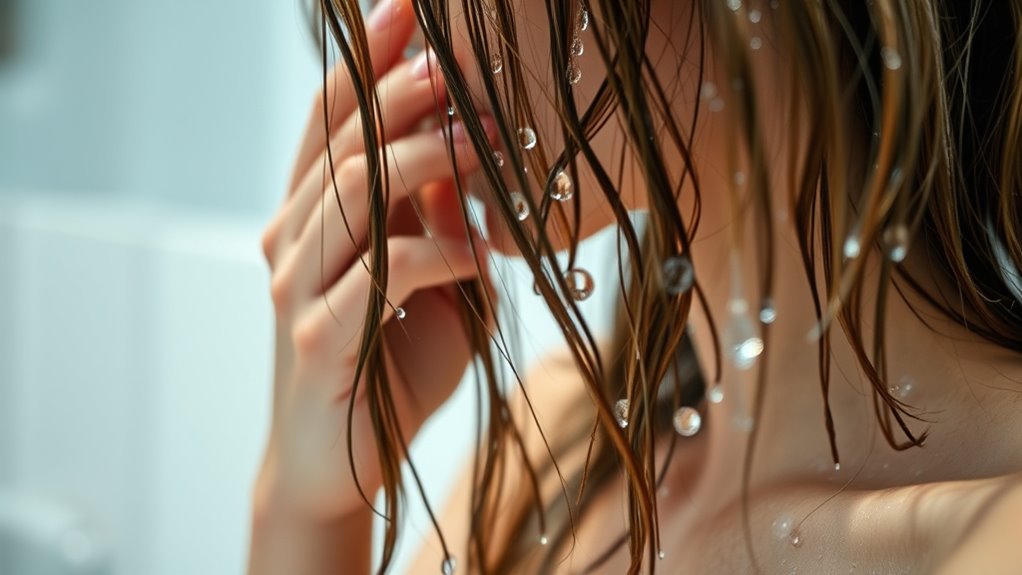
Ever wondered why your hair still feels greasy or weighed down after washing? It’s likely because you’re not rinsing thoroughly. Incomplete rinsing leaves behind shampoo or conditioner residue, which can cause frizz and dullness. Residual product buildup clogs follicles, leading to scalp irritation and potential breakage. To achieve a clean finish, rinse with lukewarm water until your hair feels free of slickness and all product is washed out. Gently detangle your hair before the final rinse to prevent breakage from tangles trapped in leftover residue. Proper rinsing not only ensures your scalp stays healthy but also prevents product buildup that can weigh hair down. Take your time with rinsing—your hair will thank you with a smoother, shinier, and less frizzy appearance.
Frequently Asked Questions
Why Is My Hair More Frizzy After Washing?
If your hair feels more frizzy after washing, you might be using hot water, which strips natural oils and causes dryness. Rubbing vigorously with a towel damages the cuticles, increasing frizz. Using the wrong shampoo or not rinsing out products thoroughly can leave buildup that makes hair look frizzier. Also, washing too often strips moisture, so consider washing with lukewarm water, gentle patting, and suitable products to reduce frizz and damage.
How to Wash Hair Without Causing Breakage?
Think of washing your hair like gently watering delicate plants—too harsh, and you risk damage. To avoid breakage, emulsify your shampoo first, then massage it into your scalp, not the ends. Rinse with lukewarm water, and avoid applying shampoo directly to wet hair. Gently squeeze out excess water with a microfiber towel before conditioning. This gentle routine helps protect your hair’s strength and prevents unnecessary breakage.
Why Does My Hair Look Frizzy and Broken?
Your hair looks frizzy and broken because you might be over-rubbing it with a towel, which damages the cuticle and causes strands to split. Hot water during washing strips natural oils, leaving hair dry and brittle. Applying conditioner on wet hair or rushing to dry it with rough towels also weakens strands, leading to frizz and breakage. Try gentle patting, cooler water, and soft drying techniques to protect your hair.
Can the Wrong Shampoo Cause Frizzy Hair?
Think of your hair as a delicate garden needing the right nourishment. Using the wrong shampoo is like watering it with harsh chemicals—stripping away essential oils and damaging the cuticles. This leaves your hair dry, rough, and frizzy, like a neglected garden choked by weeds. To keep your hair lush and manageable, select a shampoo tailored to your hair type, avoiding harsh formulas that cause damage and chaos.
Conclusion
To keep your hair healthy, stay mindful of how often you wash, choose the right products, and pay attention to water temperature. Don’t rush the drying process or skimp on rinsing; instead, be gentle and thorough. By avoiding these common mistakes, you can reduce frizz and breakage, achieve smoother strands, and enjoy vibrant, resilient hair. Remember, consistency and care are your best tools for beautiful hair—because with the right habits, your hair will thank you.
